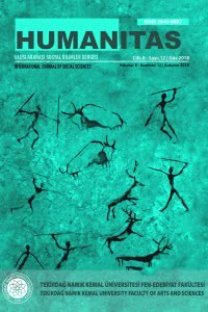Etkileşimli Yayıncılık Sistemi ve İçerik Endüstrisi İlişkisi Üzerine Bir Analiz
Yeni medya sistemi, ağ toplumunun sanal eklentili etkileşim davranışlarının şekillendiği bir yapıyı tanımlamaktadır. Etkileşim konusu, içerik ve kullanıcı arasındaki davranışların yayıncılık sistemi ile olan ilişkisine odaklanmaktadır. Günümüz yayıncılık anlayışında sanal kimliklerin aktif hale gelmesi ve yeni nesil uygulamaların küreselleşmesiyle içerik konusu önemli hale gelmektedir. İçerik endüstrisi, interaktif yayıncılık sistemi ve web tabanlı görsel-işitsel politikalarla yeni iletişim alanlarını oluşturmaktadır. Bu alanlar içerisinde IP Tv, Web Tv, OTT Tv ile çeşitli yeni nesil protokoller yer almaktadır. Bu çalışma, içerik endüstrisinin etkinlik kazandığı mecralar olarak ön plana çıkan birbirinden farklı ve bağımsız protokollerin kullanıcılar üzerindeki yönelim boyutlarını ele almaktadır. Araştırma kapsamında seçilen örnek uygulamaların etki ve popülerlik düzeyleri Google trends uygulaması üzerinden incelenmektedir.
Anahtar Kelimeler:
yeni medya, etkileşim, OTT, içerik endüstrisi, döngü modeli, Google trends
An Analysis on Interactive Publishing System and Content Industry Relationship
The new media system describes a structure in which the virtual plug-in interaction behaviors of the network society are shaped. The topic of interaction focuses on the relationship between the behavior between the content and the user with the publishing system. In today's publishing understanding, with the activation of virtual identities and the globalization of new generation applications, the topic of content is becoming important. The content industry is creating new areas of communication with interactive publishing system and web-based audiovisual policies. These areas include IP Tv, Web Tv, OTT Tv and various new generation protocols. This study deals with the dimensions of user orientation of different and independent protocols that come to the fore as the channels through which the content industry gains activity. The impact and popularity levels of the sample applications selected within the scope of the research are examined through the Google trends application.
Keywords:
new media, interaction, OTT, content industry, loop model, Google trends,
___
- Aydemir, M. ve Fetah, V. (2022). Dijital oyun ortamında NFT kullanımı ve oyna-kazan modelinin yapısal analizi. TRT Akademi Dergisi, 7(16), 970-1005. https://doi.org/10.37679/trta.1143010 Erişim Tarihi: 24.09.2022
- Aydemir, M. (2020). Yeni medyanın IPTV ve sosyal ağların bireysel erişimli ortamlarında sanal kimliklerin inşası: üniversite öğrencileri üzerine yapılan bir araştırma, (Yayımlanmamış doktora tezi). Ege Üniversitesi, İzmir.
- Aziz, A. (1990). Araştırma yöntemleri-teknikleri ve ı̇letişim. Ankara: A. Ü. Siyasal Bilgiler Fakültesi ve Basın-Yayın Yüksekokulu Basımevi.
- Ball-Rokeach, S. J. (1998). A theory of media power and a theory of media use: Different stories, questions, and ways of thinking. Mass Communication & Society, 1(1-2), 5-40. https://doi.org/10.1080/15205436.1998.9676398 Erişim Tarihi: 26.09.2022
- Berelson, B. (1952). Content analysis in communication Research. New York: Free Press.
- Berelson, B., ve Lazarsfeld, P. F. (1948). The analysis of communication content. Chicago: University of Chicago Press.
- Bilgin, N. (2006). Sosyal bilimlerde içerik analizi teknikler ve örnek çalışmalar. (2. baskı). İstanbul: Siyasal.
- Bryant, J., Zillmann, D. ve Beth Oliver, M. (2011). Media effects advances in theory and research. UK: Routledge.
- Cervellin, G., Comelli, I. ve Lippi, G. (2017). Is Google Trends a reliable tool for digital epidemiology? Insights from different clinical settings, Journal of Epidemiology and Global Health, 7(3), 185-189. https://doi.org/10.1016/j.jegh.2017.06.001 Erişim Tarihi: 27.09.2022
- Chomsky, N. (2002). Media control: the spectacular achievements of propaganda, (2. baskı). New York: Seven Stories Press.
- D’Avanzo, E. Pilato, G. ve Lytras, M. (2017). Using twitter sentiment and emotions analysis of Google trends for decisions making, Program, 51(3), 322-350. Emerald Publishing Limited 0033-0337. https://doi.org/10.1108/PROG-02-2016-0015 Erişim Tarihi: 12.10.2022
- DeFleur, M., ve Ball-Rokeach, S.J. (1989). Theories of mass communication (5th Ed.). New York: Longman Publishing.
- Dergiades, T., Milas, C. ve Panagiotidis, T. (2015). Tweets, Google trends, and sovereign spreads in the GIIPS, Oxford Economic Papers, 67(2), 406-432. Oxford University Press. https://www.jstor.org/stable/43773209 Erişim Tarihi: 23.09.2022
- Google Trends. (2022, 02 Ekim). Araştırma kavramlarının zaman ve ilgi düzeylerinin görünümü. https://trends.google.com.tr/trends/explore?q=%2Fg%2F11g0g4sbp3,METAVERSE,OTT,%2Fm%2F043z7d,WEB%20TV
- Gökçe, O. (2006). İçerik çözümlemesi kuramsal ve pratik bilgiler. İstanbul: Siyasal Kitabevi.
- Hollifield, C. A., Wicks, J. L., Sylvie, G. ve Lowrey, W. (2015). Media management: A casebook approach, (5. baskı). UK: Routledge.
- Işık, U., Kalem, M., Aliyeva, F., ve Ülker, M. (2022). Medya bağımlılığı teorisi doğrultusunda Instagram: Ünı̇versite öğrencileri üzerı̇ne bir araştırma. Yeni Medya, 2022(12), 97-116. https://doi.org/10.55609/yenimedya.1107775 Erişim Tarihi: 16.09.2022
- Jun, Seung-Pyo., Yoo, Hyoung Sun ve Choi, San (2018). Ten years of research change using Google Trends: From the perspective of big data utilizations and applications, Technological Forecasting and Social Change, 2018(130), 69-87. https://doi.org/10.1016/j.techfore.2017.11.009. Erişim Tarihi: 08.09.2022
- Krippendorff, K. (2013). Content analysis: An introduction to its methodology (3. baskı). London: Sage Publications.
- Mavragani, A., Ochoa, G., ve Tsagarakis, K. (2018). Assessing the methods, tools, and statistical approaches in Google trends research. Systematic Review J Med Internet Res. 2018; 20(11): e270 https://doi.org/10.2196/jmir.9366. Erişim Tarihi: 13.09.2022
- McLuhan, M. (1962). The Gutenberg galaxy: The making of typograhic man. Toronto: University of Toronto Press.
- Nuti, SV., Wayda, B., Ranasinghe, I., Wang, S., ve Dreyer, R. P. (2014). The use of Google trends in health care research: A Systematic Review. PLoS ONE, 9(10): e109583. https://doi.org/10.1371/journal.pone.0109583 Erişim Tarihi: 03.10.2022
- Perse, E. M. (2001). Media effects and society. UK: Routledge.
- Van Dijk, J. (2005). Network society, (2nd Edition). California: Sage Publications.
- ISSN: 2147-088X
- Yayın Aralığı: Yılda 2 Sayı
- Başlangıç: 2013
- Yayıncı: Namık Kemal Üniversitesi
Sayıdaki Diğer Makaleler
Kırgız Tiyatrosunda Kadının Varoluşu (1920-1990)
Emeğini Evin Geçimine Özgüleyen Eşin, Diğer Eşten Karşılık Talebi
Türkçede ediz > égiz “Yüksek, Yüce” Sözcüğü Üzerine
İklim Politika Belgelerinde İklim Dostu Kentler ve Dirençlilik Stratejileri
Hicran HAMZA ÇELİKYAY, Hülya KÜÇÜK BAYRAKTAR
İngiliz Romantik Şiirinin Yapay Zekâ Teknolojisiyle Görselleştirilmesi
Merve AYDOĞDU ÇELİK, Yarkın ÇELİK
Etkileşimli Yayıncılık Sistemi ve İçerik Endüstrisi İlişkisi Üzerine Bir Analiz
